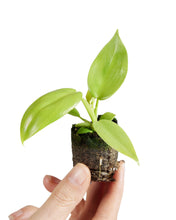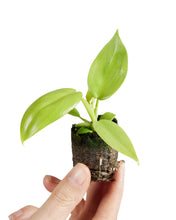Philodendron bipennifolium is part of the Araceae family and its native range is S. Venezuela to N. & E. Brazil where it grows as a climber primarily in the wet tropical biome. Like many Philodendrons this plant will go through a morphogenesis; juvenile leaves differ greatly from mature ones. P. bipennifolium has a hemiepiphyte growth habit and requires a support to allow it to climb.
“The adult form of Philodendron bipennifolium normally has two upwardly pointing lobes which narrow sharply. Then the blade again widens to form a leaf that appears to have a "fat" mid-section with a pointed lower blade.” (https://www.exoticrainforest.com/Philodendron%20bipinnafolium%20pc.html)
Genus name comes from the Greek ‘philo’ meaning loving and ‘dendro’ meaning tree. The specific epithet refers to the feather-like, bipinnate form of the leaves.
Light: Philodendron 'Golden Violin' thrives in bright, indirect light. Strong, direct sunlight can scorch its leaves and diminish the vibrant golden coloration, while insufficient light may result in slower growth and duller green foliage. A position near a window with filtered light in a typical UK home is ideal.
Water: The potting mix should be kept consistently moist but not saturated. Allow the upper inch or two of the soil to dry between waterings. Ensure the pot has excellent drainage to prevent root issues, which can be a common problem, especially in the UK's climate. Reduce watering in autumn and winter when the plant's growth naturally slows.
Soil: An airy and well-draining potting mix is essential. A mix specifically formulated for aroids, incorporating materials such as coco coir, perlite, and orchid bark, is often recommended to provide the necessary aeration and drainage.
Fertilising: Use a diluted liquid fertiliser every two to three weeks during the active growing period in spring and summer. Reduce or stop fertilising during the autumn and winter months.
Temperature: This plant prefers warm temperatures, ideally between 18°C and 27°C. It should be shielded from cold draughts and sudden temperature changes, which can occur indoors, particularly during colder UK months.
Humidity: Higher humidity levels are highly beneficial for Philodendron 'Golden Violin'. Consider using a humidifier or placing the plant on a pebble tray with water to maintain optimal conditions, especially during drier indoor periods in the UK.
Growth Habit: This Philodendron typically has an upright and somewhat climbing growth habit. Providing a sturdy support such as a moss pole or trellis can encourage larger, more dramatic leaves and vigorous vertical development.
Toxicity: Like other Philodendrons, this plant is toxic if ingested by humans or pets.





